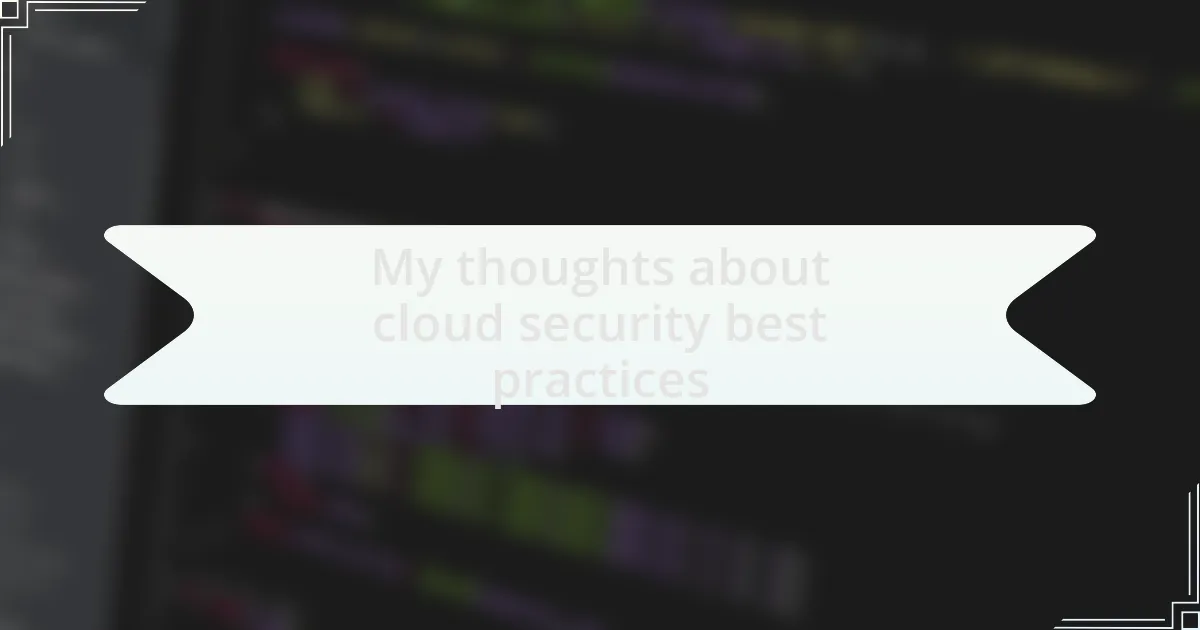Key takeaways:
- Understanding the shared responsibility model is crucial for cloud security, emphasizing both provider and user roles in data protection.
- Proactive measures like regular security assessments and data encryption can significantly enhance cloud security and prevent breaches.
- Implementing strict identity and access management (IAM) policies and maintaining data redundancy are key to reducing unauthorized access and ensuring data recovery.
- Organizations must prioritize training and compliance to navigate the complexities of multi-cloud environments and regulatory requirements.
Author: Oliver Bennett
Bio: Oliver Bennett is an acclaimed author known for his gripping thrillers and thought-provoking literary fiction. With a background in journalism, he weaves intricate plots that delve into the complexities of human nature and societal issues. His work has been featured in numerous literary publications, earning him a loyal readership and multiple awards. Oliver resides in Portland, Oregon, where he draws inspiration from the vibrant local culture and stunning landscapes. In addition to writing, he enjoys hiking, cooking, and exploring the art scene.
Understanding cloud security practices
When it comes to cloud security practices, I can’t emphasize enough how crucial it is to truly understand the shared responsibility model. This concept means that while the cloud provider secures the infrastructure, I, as a user, must also protect my data within that environment. Have you ever felt the anxiety of realizing that a simple oversight in configuring security settings could expose sensitive information? It’s a sobering thought that can keep me up at night.
In my experience, regular assessments are essential for maintaining robust cloud security. I recall a time when I overlooked routine security checks, and it nearly cost me a significant project. The realization hit me hard: proactive monitoring isn’t just a recommendation, it’s a necessity. I urge you to set reminders for yourself—these checks could be the difference between security and a breach.
Moreover, embracing encryption is something I’ve learned to prioritize. I remember the first time I encrypted data—it felt like putting up a fortress around my most precious assets. It’s incredible how this simple act can enhance security, making it much harder for unauthorized users to access sensitive information. Isn’t it worth the extra effort to protect what we value most?
Key principles of cloud security
One key principle of cloud security revolves around identity and access management (IAM). I remember an instance where implementing strict IAM policies transformed how my team handled user access. By ensuring that only the right people had the right permissions, we not only reduced the risk of unauthorized access but also boosted our confidence in the system. Can you imagine the peace of mind knowing that sensitive information is shielded from potential threats?
Another crucial aspect is the importance of data redundancy and backup strategies. I learned this the hard way when a sudden outage resulted in a loss of critical data. After that experience, I made it a priority to have multiple backups stored in different locations. Knowing that I could quickly restore lost information gave me a sense of security that is hard to quantify—how much is peace of mind worth to you?
Lastly, keeping software up to date cannot be overstated. There was a time when I hesitated to patch systems, thinking it would disrupt productivity. However, the reality hit home when I faced a security vulnerability that patching could have prevented. Staying updated isn’t just a technical detail; it’s a fundamental principle that keeps our cloud environments resilient. How many times have you weighed convenience against security, and what was the outcome?
Common cloud security challenges
Cloud security faces several persistent challenges that can undermine even the most robust systems. One issue I’ve encountered is the complexity of managing multiple cloud services. In a previous project, integrating several platforms led to confusion over data governance and access control. It made me realize how critical it is to have a clear strategy for overseeing these diverse services to prevent costly mistakes. How often do we underestimate the challenges that come with managing multiple providers?
Another common challenge is the human factor, which is often overlooked. I once had a team member accidentally expose sensitive data due to a simple misconfiguration. This incident served as a stark reminder of how crucial training and awareness are in cloud security. It brings to mind the question: Are we doing enough to educate our teams about security best practices?
Lastly, compliance with regulations can be a minefield for organizations using the cloud. I remember a client who faced hefty fines because they weren’t aware of certain industry requirements regarding data storage. Navigating through these complex regulations requires an ongoing commitment to education and policy adaptation. How many organizations have you seen struggle with compliance in their cloud environments?

Leave a Reply